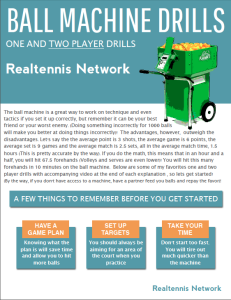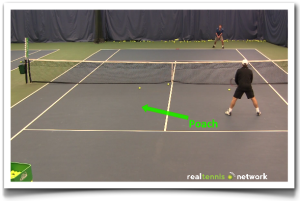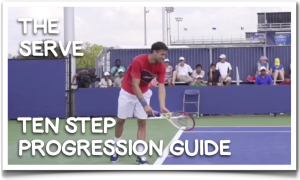How To Use The Ball Machine With Expert Stan Oley, USPTA (013)
Description
Learn how to use the ball machine with Stan Oley, Tennis Professional and Product Marketing Specialist for Playmate Ball Machines.
In Today’s episode, I talk with Ball Machine Expert, and Tennis Professional, Stan Oley, on the advantages, disadvantages, drills and why you should be using a ball machine. I follow up with questions regarding serving, putting the priorities of your game, in the right order and how to anticipate better. I also have a well put together 14 drill ball machine guide with detailed descriptions and video for one and two players that is your for FREE

Today, I talk with Ball Machine Expert, and Tennis Professional, Stan Oley, the Product Marketing Specialist for Playmate Ball Machines on the advantages, disadvantages, Drills and why you should be using a ball machine. I will go over his resume as we start the interview.
The ball machine is an awesome tool if you use it correctly. You can even use it with more than one person and even make things competitive if you like. It does not have to be a stand there and hit sort of experience. I have something that will show you what I mean that I have been working on and
Now for me personally, I trained on the ball machine quite a bit and it helped me out a lot. I was not a tennis player initially as a youngster. I was a baseball, basketball and football player with not a lot of interest in playing tennis until I started hanging out with a buddy of mine who, at the time, was ranked #2 in the country as a junior player. He hurt his wrist one summer, and said that he would teach me tennis if I taught him basketball. Needless to say, we shots baskets for about 20 minutes and then hit tennis balls for a couple hours. I loved it!
So now the next step was, how do I catch up to all of the players that have been playing for the past 6 years? My answer was to take lessons and then practice what I learned, on the ball machine. I knew that hitting with someone was good, but I could get a lot more balls in and catch up to the other players by hitting on the machine.
Let’s say that the average point is 3 shots ( this is pretty accurate), the average game is 6 points, the average set is 9 games and the average match is 2.5 sets, all in the average match time, 1.5 hours. If you do the math ( 6 points per game = 3 forehands (remember 50/50) per game x 9 games per set = 27 forehends per set x 2.5 sets in a match = 27 x 2.5 = 67.5 forehands this means that in an hour and 38 minutes ( average match time), you will hit 67.5 forehands (Volleys and serves are even lower)! Guess what……..You will hit this many forehands in 6 minutes on the ball machine ( if a ball came out every 5.3 seconds), which is actually slow for the feed rate on the machine
So is this a good thing? Definitely, if you know what you are doing. This is why the lesson before is so important, or at least some sort of  instruction from someone knowledgeable. So BEFORE you get on the machine, it would be in your best interest to know what you are supposed to be doing and even more importantly, know the FEEL of what you are doing, so you know if it is right or not.
instruction from someone knowledgeable. So BEFORE you get on the machine, it would be in your best interest to know what you are supposed to be doing and even more importantly, know the FEEL of what you are doing, so you know if it is right or not.
This way, you can “Get it right” more times when you are practicing on the machine and if it is all about muscle memory, I would think that you would want to be doing it the correct way MORE times to program your stroke patterns in a positive way. One way I say it to my students is that if you practice something wrong lot of times in a row…….guess what……you will be really good at doing it wrong! This is one disadvantage, but the advantages definitely outweigh the disadvantages, like they did for me and I know that hey can for you too.
Key points that I got from my Interview with Stan that will help the next time you use the machine
1. Practice what you need work on, not what you are good at
2. Aim for AREAS and not targets. This will boost your confidence. Targets are awfully hard to hit, but areas are much more realistic
3. Make sure that the machine does not just give you the same feed each time. If possible have it vary the height, speed and spin. This makes it more like the balls that you will RECEIVE in a match
4. Move the machine around the court instead of just in the middle. pretend it is a player and put it where you want the posing players to be (ex. returner and you are the server’s partner working on volleys down the middle).
 LISTNER QUESTIONS (More detail in podcast) – Time mark next to question
LISTNER QUESTIONS (More detail in podcast) – Time mark next to question
From: Rob – Gold River California
Question: Can you describe the timing of the weight transfer on the serve?
Go to – 55:54
To get a very detailed answer, go to www.realtennisnetwork.com/freeserveguide and check out the details on ALL 10 stages of the serve. This guide includes details and videos of the pros in all 10 stages including the weight transfer. But to answer your question, the weight will start to transfer to the back foot at the very beginning of the serve and then it will transfer FOWARD/DOWN AND UP in that order.
To keep it simple if you are starting out, when the arms go up, the knees go down ( Don’t get in the “Backscratch” here) and when the knees start to drive up and out, the arm drops (into the cocking stage with the elbow up) and then shoots up and out into the ball. You will see exactly what I am talking about in the guide. It is not one and then the next, in terms of weight transfer, but a smooth transition in both the one and two point stances after stage 1 which is the Preparation Stage. The weight transfer back is really he start of the motion after the Preparation Stage
From: Bogdan – Stuttgart, Germany
Question: Which of the following is no 1 priority for a junior player to master: technique, footwork, mental game?
Go to – 1:00:37
What a great question. This has a lot to do with development and the level of the junior. If you were starting from the ground up and I could only pick these three areas, I would put them in this order:
- Footwork
- Technique
- Mental game
The reason is that I have worked on this in our programs at our club specifically, based on the research that is out there and those I have studied who have done research on this very subject, there are two very important windows that we have to be aware of. The first window comes about around the ages of 10-12. This window is that of agility, balance and coordination or the ABC’s of athleticism. This window starts to shut around age 10 ( so basically, it gets harder to master after this), so footwork skills should be addresses first. I have a summer camp for young players where they play tennis first and then a second sport ( a different one each day for 8 days) in order to help them learn the skills needed for any sport (hopefully tennis). Harder today because of the tablet generation.
The second window is at the age of puberty where bodies start going through some major changes. Having skill-sets in place before this stage is essential as well. For example I know runners, especially females, that ran the mile faster BEFORE puberty, because of the changes their body went through after puberty.
I would put technique as second. This goes along with coordination, but what about strategy? Strategy and te





